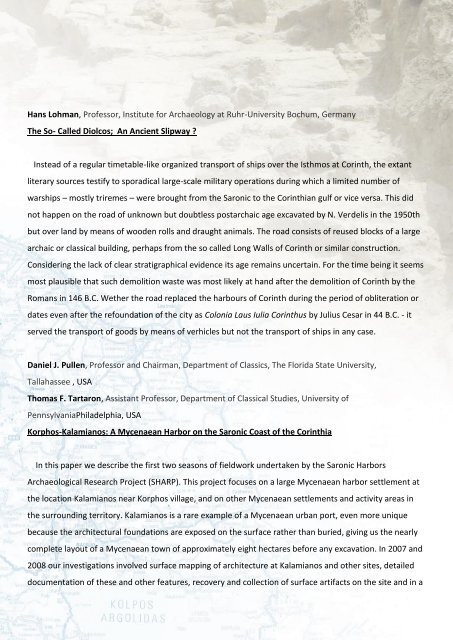ABSTRACTS - The American School of Classical Studies at Athens
ABSTRACTS - The American School of Classical Studies at Athens
ABSTRACTS - The American School of Classical Studies at Athens
Create successful ePaper yourself
Turn your PDF publications into a flip-book with our unique Google optimized e-Paper software.
Hans Lohman, Pr<strong>of</strong>essor, Institute for Archaeology <strong>at</strong> Ruhr-University Bochum, Germany<br />
<strong>The</strong> So- Called Diolcos; An Ancient Slipway ?<br />
Instead <strong>of</strong> a regular timetable-like organized transport <strong>of</strong> ships over the Isthmos <strong>at</strong> Corinth, the extant<br />
literary sources testify to sporadical large-scale military oper<strong>at</strong>ions during which a limited number <strong>of</strong><br />
warships – mostly triremes – were brought from the Saronic to the Corinthian gulf or vice versa. This did<br />
not happen on the road <strong>of</strong> unknown but doubtless postarchaic age excav<strong>at</strong>ed by N. Verdelis in the 1950th<br />
but over land by means <strong>of</strong> wooden rolls and draught animals. <strong>The</strong> road consists <strong>of</strong> reused blocks <strong>of</strong> a large<br />
archaic or classical building, perhaps from the so called Long Walls <strong>of</strong> Corinth or similar construction.<br />
Considering the lack <strong>of</strong> clear str<strong>at</strong>igraphical evidence its age remains uncertain. For the time being it seems<br />
most plausible th<strong>at</strong> such demolition waste was most likely <strong>at</strong> hand after the demolition <strong>of</strong> Corinth by the<br />
Romans in 146 B.C. Wether the road replaced the harbours <strong>of</strong> Corinth during the period <strong>of</strong> obliter<strong>at</strong>ion or<br />
d<strong>at</strong>es even after the refound<strong>at</strong>ion <strong>of</strong> the city as Colonia Laus Iulia Corinthus by Julius Cesar in 44 B.C. - it<br />
served the transport <strong>of</strong> goods by means <strong>of</strong> verhicles but not the transport <strong>of</strong> ships in any case.<br />
Daniel J. Pullen, Pr<strong>of</strong>essor and Chairman, Department <strong>of</strong> Classics, <strong>The</strong> Florida St<strong>at</strong>e University,<br />
Tallahassee , USA<br />
Thomas F. Tartaron, Assistant Pr<strong>of</strong>essor, Department <strong>of</strong> <strong>Classical</strong> <strong>Studies</strong>, University <strong>of</strong><br />
PennsylvaniaPhiladelphia, USA<br />
Korphos-Kalamianos: A Mycenaean Harbor on the Saronic Coast <strong>of</strong> the Corinthia<br />
In this paper we describe the first two seasons <strong>of</strong> fieldwork undertaken by the Saronic Harbors<br />
Archaeological Research Project (SHARP). This project focuses on a large Mycenaean harbor settlement <strong>at</strong><br />
the loc<strong>at</strong>ion Kalamianos near Korphos village, and on other Mycenaean settlements and activity areas in<br />
the surrounding territory. Kalamianos is a rare example <strong>of</strong> a Mycenaean urban port, even more unique<br />
because the architectural found<strong>at</strong>ions are exposed on the surface r<strong>at</strong>her than buried, giving us the nearly<br />
complete layout <strong>of</strong> a Mycenaean town <strong>of</strong> approxim<strong>at</strong>ely eight hectares before any excav<strong>at</strong>ion. In 2007 and<br />
2008 our investig<strong>at</strong>ions involved surface mapping <strong>of</strong> architecture <strong>at</strong> Kalamianos and other sites, detailed<br />
document<strong>at</strong>ion <strong>of</strong> these and other fe<strong>at</strong>ures, recovery and collection <strong>of</strong> surface artifacts on the site and in a

















